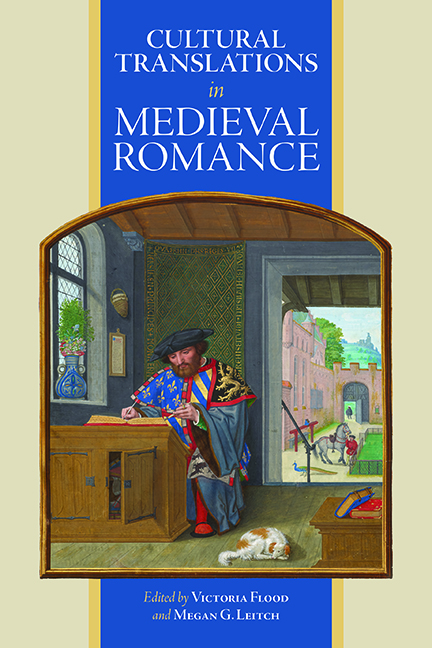Book contents
- Frontmatter
- Contents
- List of Contributors
- List of Abbreviations
- Introduction Insular Romance in Translation: New Approaches
- 1 Romantic Wales: Imagining Wales in Medieval Insular Romance
- 2 ‘Something remains which is not open to my understanding’: Enigmatic Marvels in Welsh Otherworld Narratives and Latin Arthurian Romance
- 3 The Supernatural Company in Cultural Translation: Dafydd ap Gwilym and the Roman de la Rose Tradition
- 4 Women and Werewolves: William of Palerne in Three Cultures
- 5 ‘Better a valiant squire than a cowardly knight’: Gender in Guruns strengleikr (The Lay of Gurun)
- 6 ‘Vinegar upon Nitre’? Walter Map’s Romance of ‘Sadius and Galo’
- 7 The Three Barriers to Closure in Hue de Rotelande’s Ipomedon and the Middle English Translations
- 8 Trojan Trash? The Seege or Batayle of Troye and the Learning of ‘Popular’ Romance
- 9 Poaching Romance: Fan Fiction Theory and Shared Medieval Narratives
- 10 Between Epic and Romance: The Matter of England and the Chansons de Geste
- 11 Geographies of Loss: Cilician Armenia and the Prose Romance of Melusine
- 12 ‘All this will not comfort me’: Romancing the Ballad in The Squire of Low Degree
- 13 Merchants in Shining Armour: Chivalrous Interventions and Social Mobility in Late Middle English Romance
- Index of Manuscripts
- General Index
- Miscellaneous Endmatter
7 - The Three Barriers to Closure in Hue de Rotelande’s Ipomedon and the Middle English Translations
Published online by Cambridge University Press: 07 October 2022
- Frontmatter
- Contents
- List of Contributors
- List of Abbreviations
- Introduction Insular Romance in Translation: New Approaches
- 1 Romantic Wales: Imagining Wales in Medieval Insular Romance
- 2 ‘Something remains which is not open to my understanding’: Enigmatic Marvels in Welsh Otherworld Narratives and Latin Arthurian Romance
- 3 The Supernatural Company in Cultural Translation: Dafydd ap Gwilym and the Roman de la Rose Tradition
- 4 Women and Werewolves: William of Palerne in Three Cultures
- 5 ‘Better a valiant squire than a cowardly knight’: Gender in Guruns strengleikr (The Lay of Gurun)
- 6 ‘Vinegar upon Nitre’? Walter Map’s Romance of ‘Sadius and Galo’
- 7 The Three Barriers to Closure in Hue de Rotelande’s Ipomedon and the Middle English Translations
- 8 Trojan Trash? The Seege or Batayle of Troye and the Learning of ‘Popular’ Romance
- 9 Poaching Romance: Fan Fiction Theory and Shared Medieval Narratives
- 10 Between Epic and Romance: The Matter of England and the Chansons de Geste
- 11 Geographies of Loss: Cilician Armenia and the Prose Romance of Melusine
- 12 ‘All this will not comfort me’: Romancing the Ballad in The Squire of Low Degree
- 13 Merchants in Shining Armour: Chivalrous Interventions and Social Mobility in Late Middle English Romance
- Index of Manuscripts
- General Index
- Miscellaneous Endmatter
Summary
The ending of Hue de Rotelande's ‘letter-perfect pastiche’ of romance, Ipomedon, might raise a few eyebrows amongst readers of the tradition. The hero, Ipomedon, and his on-off sweetheart, La Fière, ‘The Proud’ duchess of Calabria, are finally brought back together after being at cross purposes for some time, driven apart, paradoxically, by their devotion to the same set of chivalric ideals and equally afraid to commit to each other at different points of the story. Yet, in a departure from the virtuous tone of other such ‘tremblante’ romance reunions, their happy marriage is cast as something of an orgy: ‘Or(e) s’entreaiment tant par amur,/K’il s’entrefoutent tute jur’ (‘Now they are so much in love with each other/That they fuck each other all day long’). This salacious account of their crowning marriage is only the tip of the iceberg. In fact, it pales next to the lewd epilogue, more closely aligned to the register of a fabliau, in which ‘Hue’ propositions his female audience with
a finely veiled innuendo:
A Credenhulle a ma meisun,
Chartre ai de l’absoluciun:
S’il i ad [u] dame u pucele,
U riche vedve u damsiele,
Ne voille creire, ke jo l’ai,
Venge la: jo li musterai;
Ainz ke d’iloc s’en seit turne,
La charter li ert enbreve,
E ço n’ert pas trop grant damages,
Se li seaus li pent as nages. (lines 10569–78)
(In Credenhill at my house,/I have a charter of absolution:/If there is alady or girl,/Or fine widow or maid,/Who does not believe, that I haveit,/Let her come here: I’ll show it to her;/Before she turns from there, /The charter will be written down for her/And it won't be so very bad/If the seal hangs down from her ass-cheeks.)
Medievalists understandably find this manner of ending variously ‘boisterous’, ‘sudden, crude’, ‘provocative’, misogynistic; for Brenda Hosington it is a ‘literary hoax’, and for M. Dominica Legge it is ‘too shameless to be quoted’.
This ending is an acquired taste, and seems to provoke critical revulsion because it parodies the squeaky-clean spectacles of devotion which often mark the close of romance by suggesting they are merely a smokescreen for sexual debauchery.
- Type
- Chapter
- Information
- Cultural Translations in Medieval Romance , pp. 135 - 152Publisher: Boydell & BrewerPrint publication year: 2022

